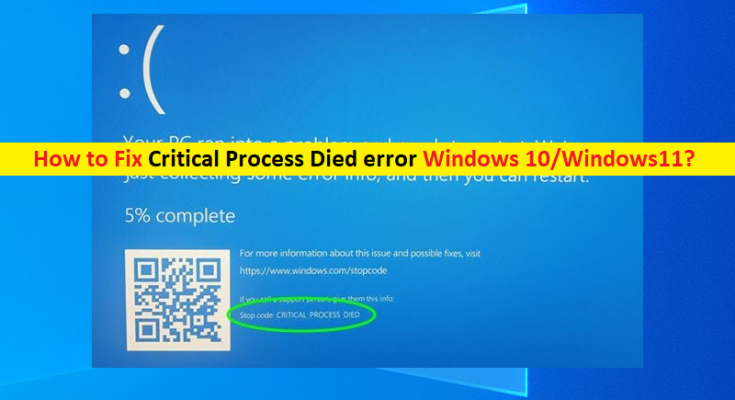What is ‘Critical Process Died error’ in Windows 10/Windows11?
If you facing ‘CRITICAL_PROCESS_DIED BSOD error’ or ‘Critical Process Died error Windows 10/Windows11’ issue in your Windows 10/11 computer in the middle of your work on computer, then you are in right place for the solution. Here, you will be guided with easy steps/methods to resolve the issue. Let’s starts the discussion.
‘CRITICAL_PROCESS_DIED BSOD error’: It is common Windows Problem considered as Blue Screen of Death (BSOD) error. This BSOD error is appeared usually in the middle of your work in Windows computer or while starting/restarting your Windows 10/11 computer. This issue indicates you are unable to work in your Windows computer comfortably or while starting/restarting your computer.
There could be several reasons behind the issue including the issue with integrated/attached hardware to your computer, issues in software program installed, malware or viruses attacks in computer, corruption in system files or registry, corruption in system hard disk system image, and other system issues.
Sometimes, this type of issue is occurred if your computer has been shutting down randomly but not properly. You can to fix the issue just shutting down your computer properly, and then after few seconds, restart your computer and check if it works. If not, then you can follow our instructions to resolve the issue. Let’s go for the solution.
How to fix Critical Process Died error Windows 10/Windows11?
Method 1: Fix ‘CRITICAL_PROCESS_DIED BSOD error’ with ‘PC Repair Tool’
‘PC Repair Tool’ is easy & quick way to find and fix BSOD errors, DLL errors, EXE errors, problems with programs/applications, malware or viruses issues, system files or registry issues, and other system issues with just few clicks.
Method 2: Update Device drivers in Windows PC
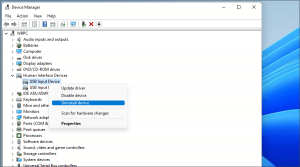
Updating all necessary device drivers to latest & compatible driver version can resolve the issue.
Step 1: Open ‘Device Manager’ in Windows PC via Windows Search Box
Step 2: Look for the device driver that is causing issue, right-click on it and select ‘Uninstall Device’ to uninstall it and after that, restart your computer. Restarting your computer will automatically reinstall all necessary drivers in computer.
Step 3: Or you can also try to reinstall the necessary drivers from your PC’s motherboard manufacturer official site, or from your device manufacturer official site that is causing issue. Once installed, restart your computer.
Download or reinstall Windows drivers update [Automatically]
You can also try to get latest updates for all Windows drivers using Automatic Driver Update Tool. You can get this tool through button/link below.
Method 3: Start Windows PC in Safe Mode
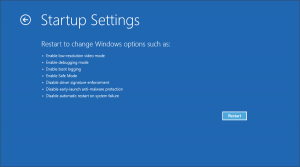
Step 1: Press & hold ‘SHIFT’ key on keyboard and restart your computer while holding ‘SHIFT’ key to open Windows Recovery Environment.
Step 2: Once opened, select ‘Troubleshoot > Advanced Options > Startup Settings > Restart’
Step 3: Press ‘5’ or ‘F5’ key to start your computer in Safe Mode with networking, and check if it works.
Method 4: Run Windows built-in troubleshooter
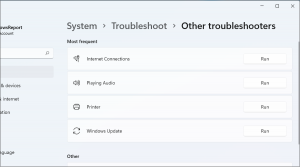
You can run Windows built-in troubleshooter in order to fix the issue.
Step 1: Open ‘Settings’ App in Windows PC and go to ‘Troubleshoot > Other troubleshooters ’, and run a couple of troubleshooter, and check if the issue is resolved.
Method 5: Run SFC Scan and DISM scan
Step 1: Type ‘cmd’ in Windows Search Box, right-click on ‘Command Prompt’ from result appear, and select ‘Run as Administrator’
Step 2: Type the following command one-by-one and hit ‘Enter’ key after each to execute
sfc /scannow
Dism /Online /Cleanup-Image /CheckHealth
Dism /Online /Cleanup-Image /ScanHealth
Dism /Online /Cleanup-Image /RestoreHealth
Step 3: Once executed, restart your computer and check if the issue is resolved.
Method 6: Uninstall problematic Windows Updates
Step 1: Open ‘Control Panel’ and go to ‘Uninstall a Program > Programs & Features > View installed updates’
Step 2: Right-click on updates you want to uninstall and select ‘Uninstall’ to uninstall it
Step 3: Once done, restart your computer and check if it works.
Method 7: Reset Windows 10/11
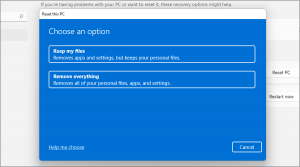
Step 1: Open ‘Settings’ App and go to ‘System > Recovery’ and click ‘Reset PC’ button
Step 2: Select the desired option and follow on-screen instructions to finish resetting and once done, restart your computer see the changes.
Conclusion
I am sure this article helped you on How to fix Critical Process Died error Windows 10/Windows11 with several easy steps/methods. You can read & follow our instructions to do so. That’s all. For any suggestions or queries, please write on comment box below.
